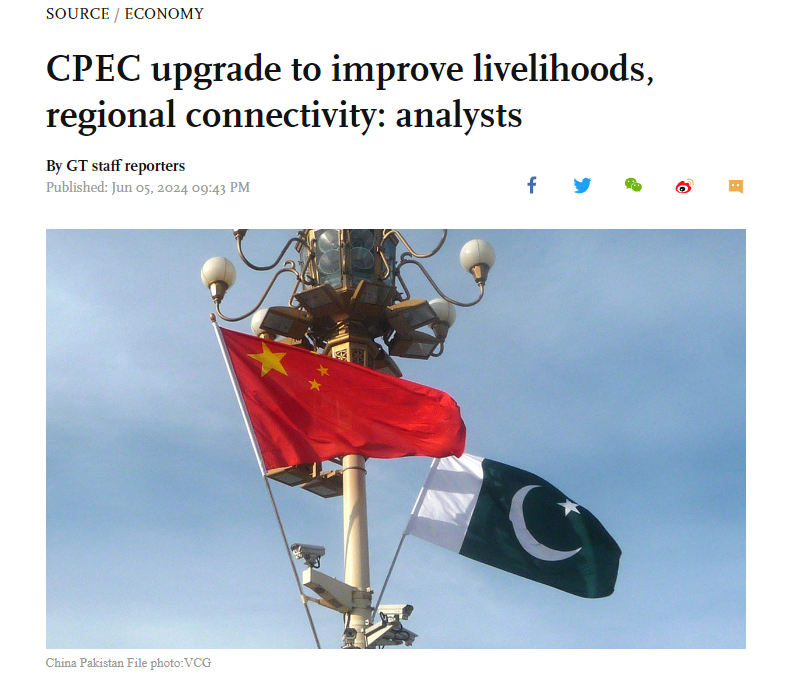LATEST INSIGHTS
Your Present Location: LATEST INSIGHTSZhou Rong: CPEC upgrade to improve livelihoods, regional connectivity: analysts
Source: GT Published: 2024-06-05

The development and upgrading of the China-Pakistan Economic Corridor (CPEC) has great prospects, especially in terms of providing more benefits to livelihoods and boosting regional connectivity, Chinese experts and corporate representatives said on Wednesday.
Pakistani Prime Minister Shehbaz Sharif kicked off his visit to China on Tuesday, with a stop at Shenzhen, South China's Guangdong Province. The trip is his first to China since he started his second term as prime minister in March.
Meng Fanli, Party chief at Shenzhen, said during his meeting on Tuesday with the Pakistani Prime Minister that the city will intensify pragmatic cooperation and exchanges with the Pakistani side, and strive for more results in the fields of trade, two-way investment, industrial innovation and people-to-people exchanges, the Shenzhen Special Zone Daily reported on Wednesday.
China and Pakistan are determined to take the upgraded version of the CPEC to new heights to advance regional connectivity, integration and common prosperity, thus forging a new era of growth and development for nations in the region and beyond, the prime minister wrote in an article in the Global Times on Wednesday.
Observers said that as China and Pakistan strive to further deepen trade and economic cooperation, more results could be anticipated in the next phase.
Based on the achievements of the CPEC's first phase, the second phase is expected to yield further economic benefits for Pakistan, they noted, noting that the prime minister's visit may involve topics such as more bilateral cooperation in areas including agriculture, economic zone development and beefing up security for Chinese personnel stationed at CPEC projects.
During the recently concluded 13th Joint Cooperation Committee Meeting on CPEC between China and Pakistan, the two sides elaborated on advancing the CPEC toward a new stage of high-quality development.
China and Pakistan identified five new corridors under the CPEC - a growth corridor, a livelihood-enhancing corridor, an innovation corridor, a green corridor and an open corridor, which are in line with the economic framework for promoting Pakistan's economic development, and they will become new engines to drive bilateral development, according to the Economic Daily.
Upgraded CPEC development also stands to benefit various sectors including agriculture, mining, information technology, science and technology, big data, cloud computing, the Internet of Things, education and the medical sector, Muhammad Zamir Assadi, a Pakistani political analyst and research fellow of the China International Press Communication Center, told the Global Times on Wednesday.
These are the sectors that can change the economic landscape of Pakistan and the region as well, and they can prove to be a job creation tool for Pakistani society, said the Pakistani scholar.
Zhou Rong, a senior researcher at the Chongyang Institute for Financial Studies at Renmin University of China, told the Global Times that one of the key projects in the second phase would be the upgrading of the Main Line-1 (ML-1) which will connect Karachi, the country's largest port, with cities in northern Pakistan, bordering the countries of Central Asia.
The upgraded rail project will provide land-locked Afghanistan with access to the sea, boosting regional interconnectivity, Zhou said, noting that this could be the most significant project in Pakistan in the next decade with its practical benefits.
Major energy construction company Power Construction Corp of China said in a statement sent to the Global Times on Wednesday that its 49.5-megawatt Sapphire Wind Farm project off Karachi, with its high equipment utilization rate, has set multiple records in harnessing wind power in the country.
CPEC connectivity has invigorated bilateral trade.
In January, the first batch of 182 tons of dried chili peppers from Pakistan arrived in Neijiang, Southwest China's Sichuan Province, under a CPEC agricultural cooperation project.
Launched in 2013, the CPEC, a flagship project of the China-proposed Belt and Road Initiative, is a corridor linking the Gwadar port in southwestern Pakistan with Kashi in Northwest China's Xinjiang Uygur Autonomous Region.























































































 京公网安备 11010802037854号
京公网安备 11010802037854号





